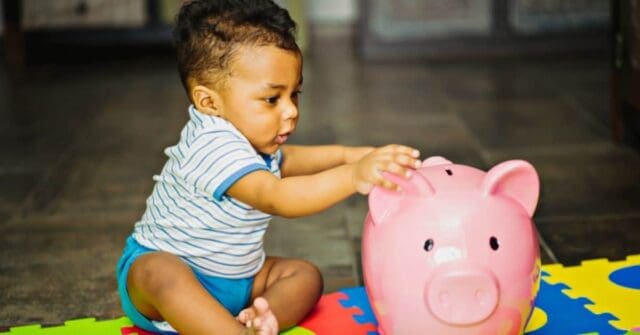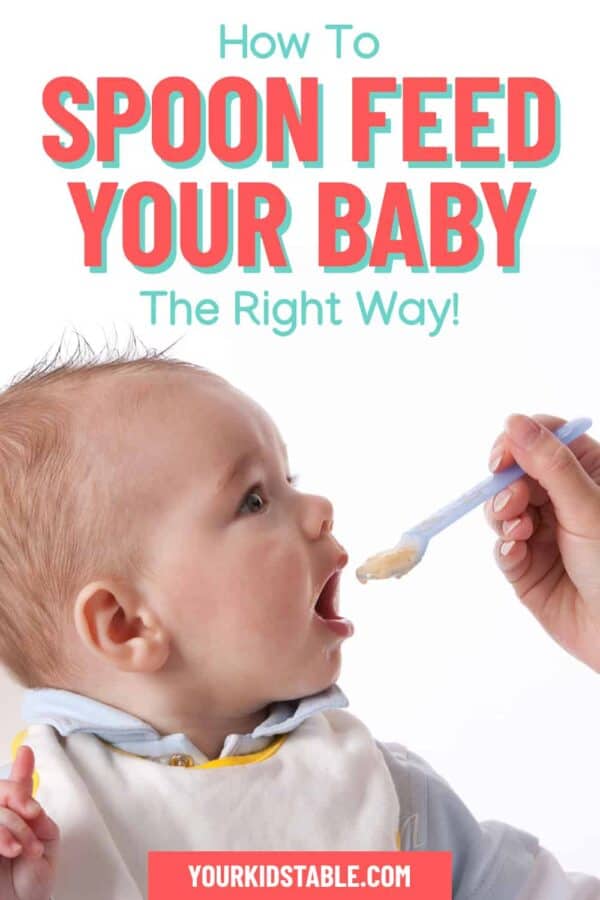Learn how to spoon feed baby even if you’re using baby led weaning, and how to troubleshoot baby gagging, throwing food on the floor, and more!
Affiliate links used below. See our full disclosure.
Starting solid foods is an exciting time for you and your baby! But, it’s easy to feel overwhelmed with exactly how to spoon feed your baby.
Is there a right way?
A wrong way?
Or, maybe your baby is having a hard time eating from a spoon?
As a pediatric OT, I’ll be answering all those questions so you can feel confident getting started or troubleshooting spoon feeding your baby.
When Should You Introduce Purees?
Let’s get started with the best time to start spoon feeding your baby.
In the past, it was recommended to introduce solids between 4-6 months. Some doctors would even recommend introducing thin cereals before that or adding them into the bottle.
Your parents may have fed you this way.
But, the American Academy of Pediatrics now recommends waiting until 6 months of age before introducing solids to your baby. They continue to recommend soft or pureed foods as the first introduction to solid foods in order to prevent choking.
We now know that babies’ digestion systems just aren’t mature enough to handle foods and that most don’t have the postural control for safe swallowing before 6 months.
Before 6 months, a powerful tongue thrust is also likely to be present which means your baby may inadvertently push the food back out of their mouth when you try to spoon feed them at an earlier age.
Parents often confuse this with a baby not liking the baby food, but it’s actually an involuntary action.
So, despite what well meaning grandparents may say, we now know waiting till 6 months is the best time frame for beginning to spoon feed your baby.
Head to our Feeding Schedule for 6-7 month olds to get an idea of how, and often when, you should be spoon feeding your baby.
What About Baby Led Weaning (BLW)?
In more recent years, there has been a huge movement towards Baby Led Weaning (BLW).
Baby led weaning is a method for introducing solid foods by allowing your baby to feed themselves rather than be spoon fed by a parent. Read about the pros and cons of Baby Led Weaning.
Baby Led Weaning gives babies the ultimate sensory experience while they eat, but it can also lead to delayed introduction of solids during your baby’s optimal window if they aren’t getting the hang of eating BLW type foods.
Some babies do really well learning to eat with BLW, and some don’t.
Whether you choose to go the BLW route or not, purees are still important to feed your baby sometimes because you’ll want them to also be able to eat foods like applesauce, yogurts, and soups.
Check out our Mega List of Table Foods for great food ideas to start with.
How to Start Spoon Feeding Baby
Step #1: Make sure that they’re 6 months old, have good head control, and can sit upright to eat and swallow.

Step #2: Get them in the right position.
The position of your baby is often overlooked. It’s easy to sit them on your lap while feeding them or feed them while they’re in the car seat. But that isn’t the safest position and can impair the development of their feeding skills.
Sitting on your lap or not in a supported seat is actually more challenging for babies. If your baby is focusing all their energy on sitting upright, they aren’t able to use their mouth as effectively.
To ensure your baby is seated properly, position them in an age appropriate booster seat or highchair with a footrest.
Ideally their hips, knees and feet should be at a 90 degree angle if possible.
This means that when babies are first learning to eat, they should have support under their feet and they shouldn’t look slumped over. Not every highchair or booster seat does a good job keeping your little one in the right position.
My absolute favorite chair that grows with them into childhood is the Tripp Trapp, it’s an investment, but they’re so well made, they last forever.
My son is 7 and has been using it since he was 6 months old!
The Keekaroo is another option that’s a little lower in price.
Step #3: Use a spoon with a flat small bowl, it’s easier for your baby to remove the food.
The bowl of the spoon is so important. You want it to be mostly flat or to have a shallow bowl. That means it can’t hold too much of the puree on it.
The spoon should also have a narrow bowl. If your baby is right around 6 months old, their mouth isn’t big. The narrow bowl fits in their mouth much better than a big wide spoon.
See a list of our favorite spoons at the end.
Step #4: Choose a totally smooth thinner baby food.
If you’re using store bought baby food use stage 1 for the first feedings. If you’re making homemade baby food, you don’t want the food to be too thick. Think about making it thick enough for baby to swallow, but not so thin it’s like liquid.
Homemade baby food at this stage should spill off the spoon easily, but still have some stuck to the spoon when you turn it upside down.
Step #5: Place the right amount of puree on the spoon.
You’ll want to avoid overfilling or under-filling the spoon. You should have some puree on it, ideally near the front of the spoon.
Avoid scooping and loading up the spoon with as much puree as possible. This can be really overwhelming to your baby, especially if they’re just learning to eat purees.
Too much food in their mouth can also trigger their gag reflex.
If your baby does gag, don’t panic, it’s normal. Gagging and choking are two different things. Read more about what to do when babies gag eating.
Step #6: Let your baby decide when to take a bite.
Place the spoon right in front of your baby and wait until they open their mouth. This puts them in charge of their responsibility right from the start, they are the ones that decide to eat.
You want to avoid opening their mouth for them or trying to sneak a bite in their mouth when they look away.
Helping your baby learn that they get to decide when to take a bite can reduce feeding battles and picky eating in the years to come.

Step #7: Place the spoon in the center of their mouth.
The spoon should go in the center of their mouth, above their tongue. You may gently use the back of the spoon to add a small bit of pressure to the middle belly of the tongue.
This is helpful if their tongue seems to be moving quite a bit.
Step 8: Wait for them to close their mouth.
When you’re excited and you really want them to take a bite, it can be hard to wait! But be sure to wait until they close their mouth on the spoon.
This lets them know what their job is, and helps lay the foundation for them to be able to feed themselves.
What to Avoid When Spoon Feeding Baby…
You have 8 simple steps to follow! But, there are a few things you’ll want to avoid. You’ll likely see others doing these things while feeding their babies, because they’re all very common.
However, each of them can cause difficulties with eating and swallowing either in the moment you’re feeding your baby or in the future. Here’s what to avoid…
- Avoid scraping food on the roof of your baby’s mouth. You want to wait until your little one closes their mouth on the spoon.
- Don’t feed them in a reclined position. Car seats, strollers, and infant positioners all should be avoided. An upright high chair or booster seat is ideal to make sure your baby doesn’t gag, choke, or aspirate.
- Avoid distractions like the TV, phone, or toys. If they’re distracted while eating, they aren’t fully experiencing all the different flavors and textures.
- No force feeding. Let your little one decide when to take a bite. This reduces the chance of picky eating later on and sets them up for positive mealtimes in the future.
In these early days, some babies need a lot of time to get used to purees. However, if your baby is reaching the 8-9 month mark and still struggling, there could be some underlying difficulties that need addressed.
See our free workshop to learn more and contact your child’s doctor.
- Don’t overfill the spoon. You want a medium amount of puree on the spoon, near the front of the bowl.
Troubleshooting Spoon Feeding Challenges
It’s very normal for babies to need some help getting the hang of eating purees. They’re learning and may need a little more time. Here’s some common challenges you might be faced with and what you can do…
Challenge #1: Your baby won’t open their mouth
When your baby won’t open their mouth for the spoon, this can be really discouraging as a parent of a new eater!
Modeling is especially helpful in these cases. Take your own spoon and a little bite of the puree. Open your mouth wide and really over exaggerate what you’re doing.
Show your baby how to do it.
You can also try placing a mirror in front of your baby while they eat or give them their own spoon that is pre-dipped with puree to try out.
Challenge #2: Your baby won’t close their mouth on the spoon
If your baby won’t close their mouth on the spoon, scraping the puree into their mouth is tempting. You want to avoid this!
It doesn’t teach them how to use their muscles to eat. It also teaches them that they have to eat a particular food, which can encourage pickiness later on.
Frequently, if they don’t close their mouth on the spoon, it’s because they don’t know they’re supposed to.
You can encourage this by very gently rolling your finger above their upper lip in a downward motion towards their mouth. Showing them how to take a bite with an exaggerated close is also helpful.
Keep practicing for up to 8 months of age before seeking more help from the doctor or a feeding therapist.
Challenge #3: Your baby gags with purees
Gagging can get a bad wrap. Gagging happens first as a protective mechanism to prevent your baby from choking. But it can also turn into a problem if it starts to happen often. Or, before food even hits their mouth.
Sometimes excessive gagging happens because your baby’s mouth is sensitive to sensory input, or the textures of food.
It can be helpful to desensitize their mouth with teethers or toothbrushing. You can brush their gums even if they don’t have teeth yet!
Challenge #4: Your baby throws their bowl or spoon
We hear parents tell us that their baby is throwing their food, plate, or utensils all the time. If your baby is doing this, you’re not alone at all!
Usually this happens just because they’re testing things out at first. It makes a fun noise or you make a funny face whenever they do it.
It can be tempting to react negatively whenever food is thrown. Try to resist the urge and stay as neutral as possible. A negative reaction is still a reaction and can sometimes encourage them to do it more.
Try using a simple phrase like, “our food stays on the tray” and move on. It can also be helpful to use plates and bowls that suction well to their highchair to buy you a bit more time before the food flies.
Learn more in how to help babies and toddlers stop throwing food.
Challenge #5: Your baby always wants to hold the spoon
This is actually such a good thing, even though it can feel frustrating when you’re just introducing purees. They’re motivated to feed themselves!
Give them a spoon of their own that has been dipped in a little bit of puree while also having your own spoon. You can take turns doing the feeding.
It might be frustrating because they will make a big mess at first and likely will get just a little bit of puree in their mouth. This is a great step towards their independence!

While 6 months is the perfect time to start spoon feeding your baby, and you should give your baby plenty of time to get the hang of it, your baby should be eating purees regularly by 8 months of age, even if it’s a small amount.
If you’ve tried all the tips and tricks we’ve suggested and they still aren’t eating solids by 9 months, it’s time to get some more help!
Our free Table Foods Workshop is the perfect place to start. It’s full of suggestions that you can start using immediately. Save your seat HERE.
Our Favorite Baby Feeding Spoons
- Take and toss spoons
- These are great spoons. They have a narrow and flatter bowl. They’re also super affordable. You certainly can take and toss them, as they suggest. But, they can also be quickly hand washed and reused. The spoons are a bit softer and more flexible. They’re great spoons to start with!
- Maroon spoon
- Maroon spoons are spoons you commonly see therapists use. They’re a bit pricier though. The bowl is relatively narrow and flat, which is perfect for babies to pull puree off of more easily. These spoons are made from harder plastic.
- Flat Spoon Dippers
- These spoons were intended for babies to feed themselves. The bowl is narrow, textured, and completely flat. There is also a guard to prevent your baby from pushing the spoon too far down. Great for reducing gagging.
- EZ PEZE bowl
- While this isn’t a spoon, it’s a great tool to have on hand when you’re feeding your baby purees. It suctions to the tray and doesn’t slip very easily. It can be really helpful, especially if your baby loves to throw their bowl.
You’re all set! It’s time to feed that sweet little baby. Try to have fun. Let your baby play, experiment, and laugh while eating.
Let them get messy! (See why here)
Got any questions? Leave them in the comments below, we respond to every single one.
And, if you want to get ready for the next steps of feeding, table foods, grab our guide for teaching your baby how to learn to chew and eat them here!
More on Feeding Babies
5 Things Parents With They’d Known Sooner About Feeding Their Baby or Toddler
Why Your Baby Should Be Putting Toys in Their Mouth
Feeding Schedule for 8, 9 and 10 Month Olds
Must-Know Pros and Cons of Using Baby Food Pouches
Andrea Timler is a licensed occupational therapist and part of the Your Kid’s Table Team. She has over 7 years experience with expertise in development and feeding in babies, toddlers, and children. Andrea also has 4 kiddos of her own at home.

Hi! We’ve just begun giving our six month old baby oatmeal/purées, but she’s only interested in chewing on the spoon. Some food inevitably is eaten, but she’s definitely not TRYING to eat. Any suggestions? Thank you!
Hi Christina! Thanks for reaching out! At least she is mouthing the spoon– that’s great! Keep allowing her to mouth teethers and practice with the solids, without any pressure. You can also try demonstrating to her how you eat with a spoon, using over-exaggerated motions. For more assistance, check out our free table foods workshop!
Best,
Kalyn
Hi there! My son (12months) has recently started to refuse food and cry while reaching for the spoon at lunch. I’ve tried giving him his own spoon with whatever he’s eating on it as well but he still refuses to eat and continues to reach and cry out for the spoon I’m feeding him with. I’ve also tried leaving the food on his plate but he refuses to eat it at lunch, breakfast he eats himself as it’s usually fruit and for his supper he has porridge before bed so will eat this as well spoonfed with no problems. I’ve found it doesn’t matter what I give him at lunch. Have you got any advice as lunchtimes are being very very chaotic and stressful
Hi Eva! Thanks for reaching out! Try having him play with a spoon/fork outside of mealtimes to get him used to the feel of these utensils. Demonstrate feeding with each other and show him how you feed yourself. Just take the pressure away and keep trying! We also have another blog post about self feeding- check it out here!
Best,
Kalyn
My almost 18mo toddler is a pretty good eater. Wide variety of flavors and textures. My recent challenge is I think gets tired feeding himself or bored with eating 1/2 way through a meal. He starts trying to shove food down the straw of his cup and finds other ways of playing with whatever is around. Screams and cries if you take these things away. But he is obviously not full yet. So while he plays and tries to stack the sriracha bottle on the 360 cup on the side of his plate, I end up spoon feeding him. I’m assuming this kind of behavior is normal and its just a phase.
Hi Brenna! Thanks for reaching out! It’s great that your toddler is eating a wide variety of foods and textures! During mealtimes, we recommend eliminating all distractions and eating together at the table, so that he can see everyone else eating. Continue to allow him to feed himself as much as possible, either with his hands or utensils, while also promoting a no-pressure environment without any force feeding. When spoon feeding him, try alternating bites- you spoon feed him one bite, then he spoon feeds himself the next bite. You can also try pre-loading his spoon with some food and leave it there on his tray for him to pick up and eat. Hope that helps! You can find more tips and information here!
Best,
Kalyn